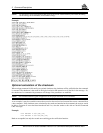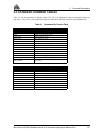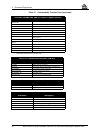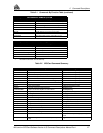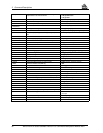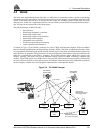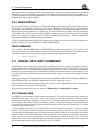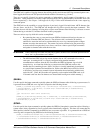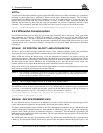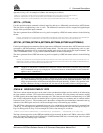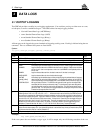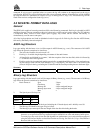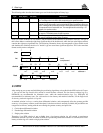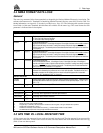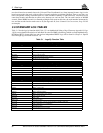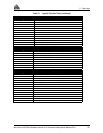
2 Command Descriptions
32 MiLLennium GPSCard Software Version 4.50 Command Descriptions Manual Rev 1
$UTCA...
Use this special data input command to quickly update the GPSCard Universal Time Coordinated (UTC) parameters
following a system restart (always appended to $
ALMA records unless intentionally stripped). The UTC data is
required before the GPSCard can accurately compute
UTC time. If not input with $UTCA, it may take up to 12.5
minutes after a reset for the GPSCard to receive current
UTCA data. In order to comply with NMEA standards, the
GPSCard will null
NMEA log data fields until valid UTC parameters are collected or injected by the $UTCA input
command. This command is generated from a GPSCard
ALMA log and is accepted as the following format:
$UTCA,-1.769512891769409E-008,-1.776356839400250E-015,552960,744,755,9,10,5*03
2.4.2 Differential Corrections Data
NovAtel MiLLennium cards can utilize the special data input commands $RTCA and $RTCM. These special data
input commands are utilized by a GPSCard operating as a remote station to accept NovAtel ASCII format
differential corrections. The data is generated by a GPSCard operating as a reference station with intent to be
received by remote stations. To correctly interpret these commands, the remote GPSCard must have its
ACCEPT
command option set to "COMMANDS" (default). See Appendix A, Page 66 for further information on differential
positioning.
$PVAA/B XYZ POSITION, VELOCITY AND ACCELERATION
The $PVAA and PVAB data messages contain the receiver’s latest computed position, velocity and acceleration.
These quantities are in rectangular ECEF coordinates based on the centre of the WGS 84 ellipsoid.
When a GPSCard receives this data message, it uses the information to update its own position, velocity and
acceleration parameters. This would only be needed if the GPSCard could not compute its own position, velocity
and acceleration due to signal blockage. This data message helps the receiver reacquire satellites after loss of lock.
The data would aid the receiver channels in the re-acquisition process; thus, the receiver would “follow” the
blocked satellites and re-acquire them much more quickly when they become visible again.
The position, velocity and acceleration status fields indicate whether or not the corresponding data are valid. Only
those messages containing valid data are used by the GPSCard.
NOTE 1: This command is intended for applications involving very high dynamics - where significant position,
velocity and acceleration changes can occur during a signal blockage. This data message helps the
receiver reacquire satellites after loss of lock.
NOTE 2: This is a highly complex function, to be used only by advanced users.
The ASCII $
PVAA data message is generated from a PVAA log, and the binary PVAB data message is generated from
a
PVAB log. For descriptions of these data messages, please see the description of the PVAA/B logs in Chapter 4,
Page 34 and Appendix D, Page 181. An example of a $
PVAA data message is as follows:
$PVAA,845,344559.00,-1634953.141,-3664681.855,4942249.361,-0.025,0.140,
0.078,0.000,-0.000,0.000,1,1,1*02
$REPA/B RAW GPS EPHEMERIS DATA
In cases where the receiver does not have an ephemeris for a newly-viewed satellite, these data messages can be
used to reduce the time required to incorporate this satellite into the position solution
The $
REPA and REPB data messages contain the raw binary information for subframes one, two and three from the
satellite with the parity information removed. Each subframe is 240 bits long (10 words - 25 bits each) and the log
contains a total 720 bits (90 bytes) of information (240 bits x 3 subframes). This information is preceded by the
PRN number of the satellite from which it originated. This message will not be generated unless all 10 words from
all 3 frames have passed parity.
The ASCII $
REPA data message is generated from a REPA log, and the binary REPB data message is generated from
a
REPB log. For descriptions of these data messages, please see the description of the REPA/B logs in Chapter 3 and



